Amerika is the MOST Hated Country in the World & This is Why-KILLING CHILDREN! I’m An American And I Don’t Support ANY of These CIA/Special Forces Crimes Being Done in My Name.
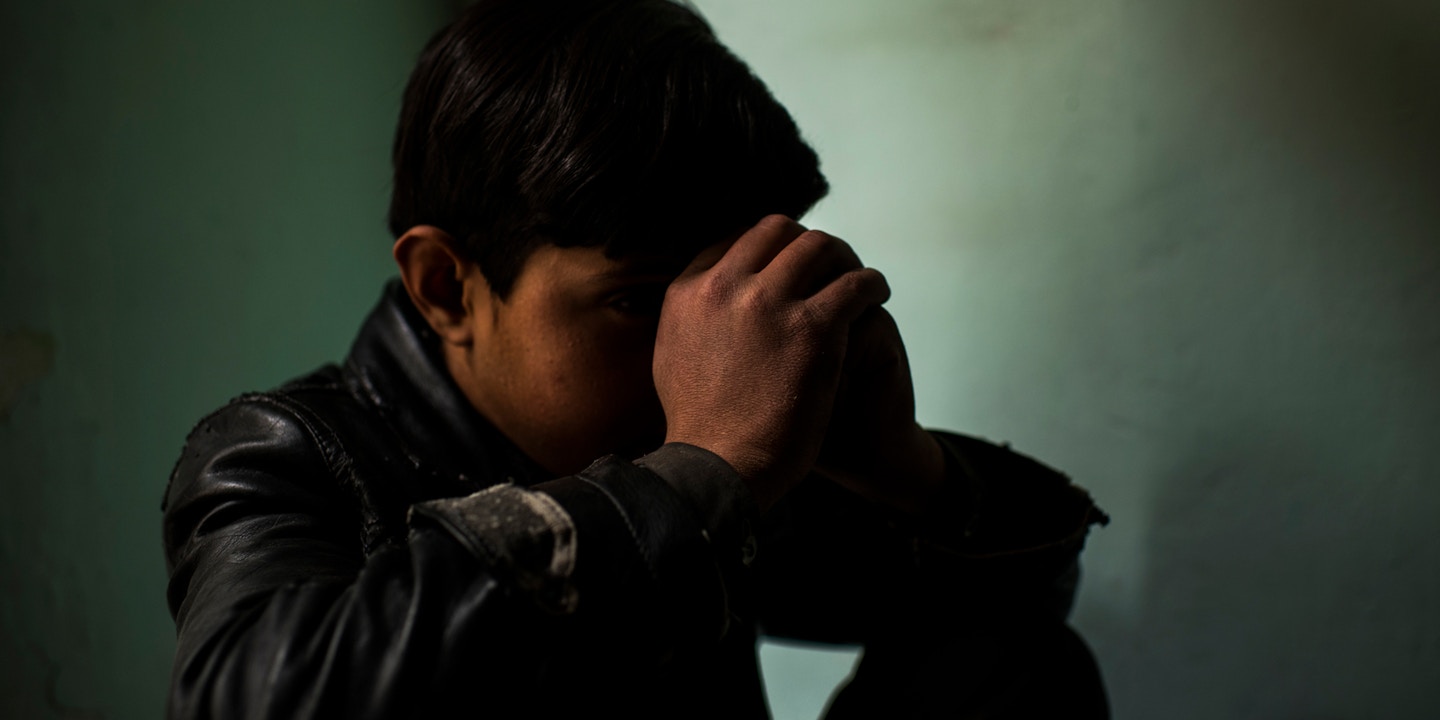
THE CIA’S AFGHAN DEATH SQUADS
A U.S.-Backed Militia That Kills Children May Be America’s Exit Strategy From Its Longest War
DONATE5512-year-old Bilal survived a December 2018 night raid on his madrassa in Afghanistan’s Wardak Province, during which 12 other boys were massacred. “There were Americans in the corridor,” Bilal told The Intercept. “We could hear them speaking.” Photo: Andrew Quilty/Agence Vu

Andrew Quilty
December 18 2020, 3:01 a.m.
THE BUZZ OF a drone at night was the first sign of trouble.
Next came the roar of a larger, low-flying aircraft, which alerted residents of the Afghan village of Omar Khail that soldiers were nearby. Men in camouflage moved through the streets speaking Pashto and English. It was December 2018, and the air was frigid. They made their way to the madrassa, or religious school, where more than two dozen boys between the ages of 9 and 18 slept on the floors of several dormitory rooms.
A neighbor watching from a window across the street saw a flash and heard a loud explosion as the front gate of the madrassa was blown open. Inside, the noise awakened 12-year-old Bilal, who was huddled in a room with nine other boys when an Afghan soldier burst through the door.
“Wake up!” the man yelled in Pashto, pointing at the boys one by one with the barrel of his rifle, which was mounted with a flashlight. A second soldier entered, chose the two tallest boys, and led them out the door. The first soldier turned to leave, but before he did, he issued a warning to the rest of the boys cowering before him: “If I find you in this madrassa again, we won’t leave a single child alive.”
https://embed.acast.com/intercepted-with-jeremy-scahill/thecia-safghandeathsquads?accentColor=111111&bgColor=f5f6f7&logo=false
Bilal and the others squeezed together as far from the door as they could, with their backs to a large window facing a central courtyard. Many were in tears; others couldn’t speak. From the hallway, Bilal heard words he recognized as English.
“They’re not going to let us live,” a student murmured.
In preparation for death, some of the boys recited the Muslim declaration of faith, known as the Shahada: “There is no God but Allah, and Muhammad is his messenger.”
Just then, the sound of automatic gunfire tore along the corridor. “For a very short time,” Bilal said, it sounded like “there were many guns.” Boys’ screams came next, followed by two loud explosions. “One shook the whole building,” said Bilal. “We didn’t hear anything after this. Everyone was silent.”
When the sun rose hours later, Bilal and about a dozen other students remained crouching in silence, some still trembling with fear. Nearby, in two of the school’s other rooms and in the basement, 12 more boys, their bodies mauled by bullets, lay crumpled on the floor.
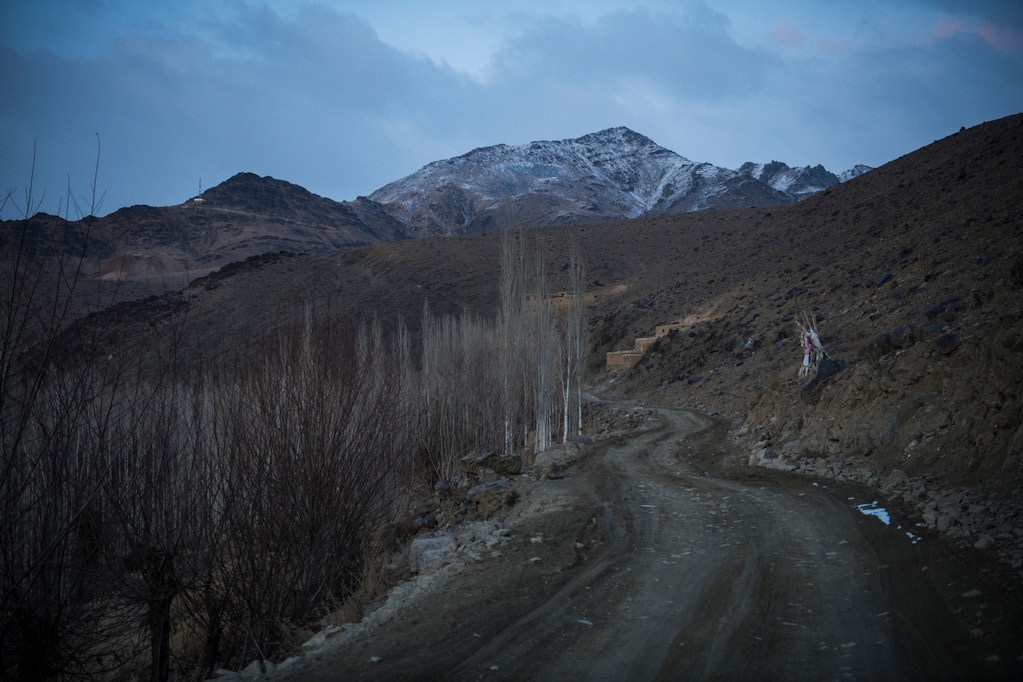
The main road through Wardak’s Chak District, where night raids by the CIA-led 01 strike force unit and accompanying U.S. airstrikes killed more than a dozen civilians in 2018 and 2019.
Photo: Andrew Quilty/Agence Vu
THE 12 BOYS KILLED in the madrassa at Omar Khail that winter night were among scores of civilians massacred during at least 10 previously undocumented night raids in the central Afghan province of Wardak. Beginning in December 2018 and continuing for at least a year, Afghan operatives believed to belong to an elite CIA-trained paramilitary unit known as 01, in partnership with U.S. special operations forces and air power, unleashed a campaign of terror against civilians. This story is based on interviews with more than 50 Wardak residents, including 20 survivors and firsthand witnesses and 29 victims’ relatives and local residents who witnessed the aftermath of the killings within hours of when they occurred. Some of those accounts were corroborated by local officials, analysts, and community representatives.
The 10 raids resulted in the deaths of at least 51 civilians, according to The Intercept’s reporting. In most cases, men and boys as young as 8, few of whom appear to have had any formal relationship with the Taliban, were summarily executed. Some died alone, others alongside friends and family. Several raids were accompanied by airstrikes or, in at least one instance, the detonation of hand-laid explosives targeting structures known to be occupied by civilians.
The Intercept has changed the names of those killed in the raids and of the survivors, witnesses, and victims’ relatives we spoke with to shield them from further harm. Some requested anonymity because they feared retribution from pro-government forces, while others worried the Taliban would punish them for speaking candidly to a journalist.
Residents from four districts in Wardak — Nerkh, Chak, Sayedabad, and Daymirdad — spoke of a string of massacres, executions, mutilation, forced disappearances, attacks on medical facilities, and airstrikes targeting structures known to house civilians. The victims, according to these residents, were rarely Taliban.Yet the Afghan unit and its American masters have never been publicly held accountable by either the Afghan or U.S. governments.
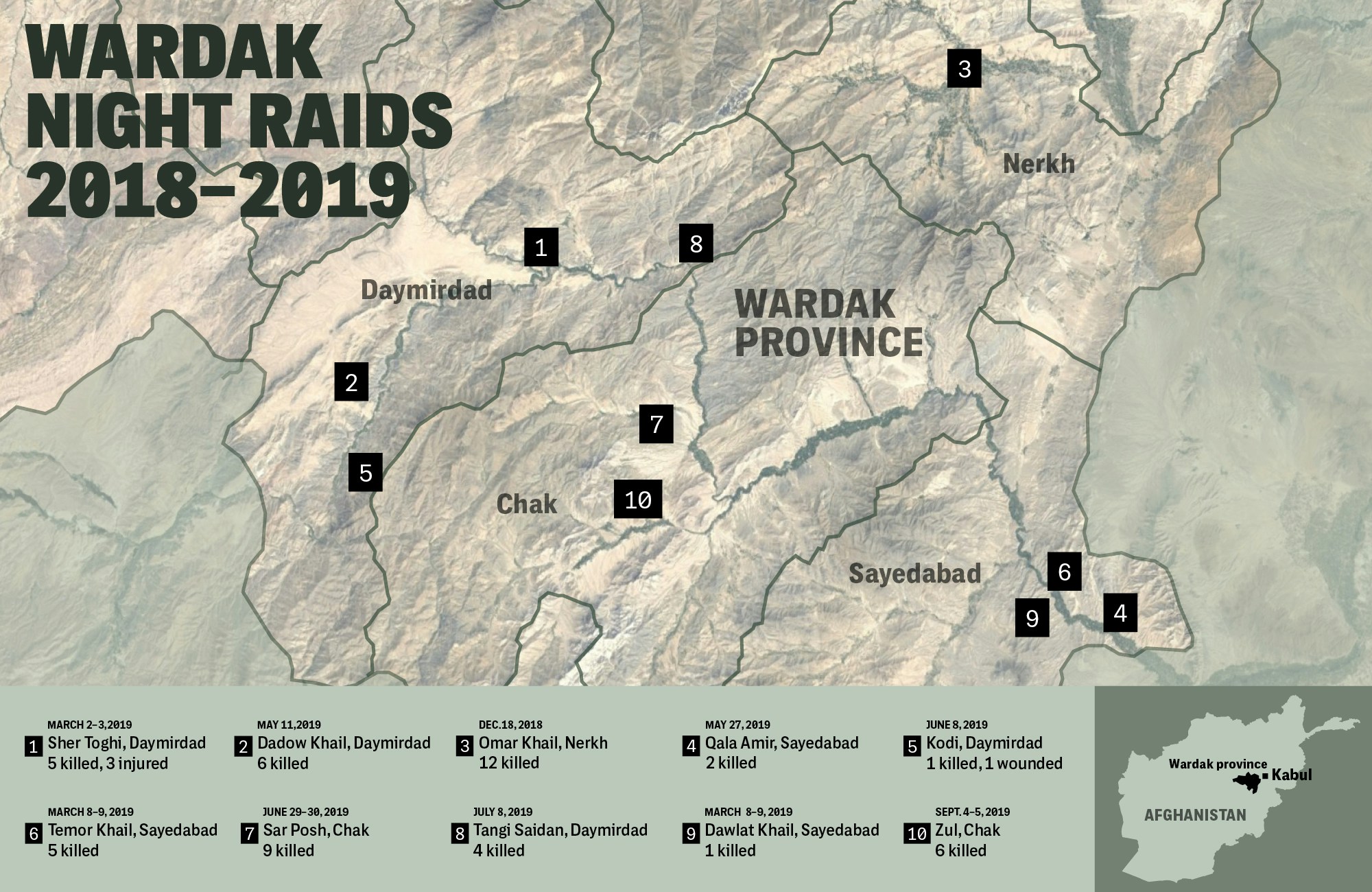
A map shows the locations of at least 10 previously undocumented night raids by Afghan operatives believed to belong to an elite CIA-trained paramilitary unit known as 01.
Map: The Intercept
The Americans “step on all the rules of war, human rights, all the things they said they’d bring to Afghanistan,” said Wardak provincial council head Akhtar Mohammad Tahiri. They are “conducting themselves as terrorists. They show terror and violence and think they’ll bring control this way.”
Known collectively as strike force units because of their targeted, aggressive methods, the shadowy CIA-backed militias nominally fall under the purview of the National Directorate of Security, or NDS, Afghanistan’s intelligence service. They are comprised of 01, which operates primarily in central Afghan provinces including Wardak and Logar; 02, which is based in Jalalabad and works in the eastern part of the country; 03, also known as the Kandahar Strike Force, which operates in the south; and 04, which conducts raids in Kunar and adjacent provinces in the northeast. Two units in the southeast, the Khost Protection Force and the Shaheen Forces, the latter of which emerged in the eastern Afghan province of Paktika in 2019, are believed to function under similar authority.
The units’ American CIA advisers go by pseudonyms or call signs rather than names. They not only train Afghan unit members, but also choose their targets, which the Americans call “jackpots”; issue detailed pre-mission briefings; and accompany Afghan paramilitaries on the ground during raids. The Afghans and Americans are ferried to remote villages at night by American helicopters, and American assault aircraft hover overhead while they conduct their raids, providing lethal firepower that is sometimes directed at health clinics, madrassa dormitories, or civilian homes.Madrassa Killings
- May 11, 2019, Dadow Khail: Soldiers entered the village madrassa and came out with several boys. “We heard the boys begging for their lives — screaming and crying,” said Safiullah Mahmand, 27. “Then we heard the shooting.” At dawn, an old man discovered a pile of six boys’ bodies at the mouth of an irrigation channel. The youngest victim was 10.
- June 29, 2019, Sar Posh: Helicopters descended into a valley, disgorging soldiers who destroyed the home of a local Taliban commander before turning up a narrow valley to the village madrassa. When the shooting and explosions subsided and the soldiers left, locals laid the bodies of nine boys in a row outside. “People said, ‘01 came with Americans in a night raid,’” a victims’ relative told The Intercept. They “went to the madrassa, threw grenades, and killed the students.”
“I don’t know whether they’re special forces or a task force or CIA,” said an NDS counterterrorism officer from Wardak who accompanied 01 on missions until late 2018, but “Americans are always with them.”
The CIA has a long history of training, arming, and funding indigenous militia networks. Since its birth in 1947, the agency has supported anti-communist outfits in Greece, Cuba, Vietnam, Laos, and Central America, as well as the Afghan mujahedeen in the 1980s. Since the September 11 attacks, the CIA has repurposed and supercharged those methods, dispensing training and weapons to supposed allies from Somalia to Syria with dubious results.
But the level of CIA involvement in Afghanistan since the war on terror began has few precedents. In 2013, more than $2.5 billion — nearly 5 percent of the entire U.S. intelligence budget — was allocated for covert action, the category under which the agency’s Afghan strike force unit program falls, according to documents leaked by National Security Agency whistleblower Edward Snowden. From establishing the strike force units to selecting their targets, overseeing their missions, and using special operations forces borrowed from the Pentagon to coordinate air support, the network of CIA-run militias in Afghanistan is perhaps the most dramatic manifestation, apart from America’s well-documented drone program, of the secret war the U.S. intelligence agency is waging around the globe.
The CIA “has long seen [Afghanistan] as their war,” said Patricia Gossman, an associate director for the Asia division at Human Rights Watch who has worked in Afghanistan since the 1990s.Join Our NewsletterOriginal reporting. Fearless journalism. Delivered to you.I’m in
As the U.S. withdraws, the unaccountable militias it has nurtured are beginning to look like a valuable proxy for regular military forces under the leadership of Joe Biden, who as vice president advocated a lighter military footprint and greater focus on counterterrorism in Afghanistan. Biden was credited in 2010 with convincing President Barack Obama to adopt a more aggressive approach in Afghanistan, doubling down on drones, intelligence operatives, and small teams of door-kicking special forces in place of the “hearts and minds” counterinsurgency approach implemented by General Stanley McChrystal and continued under his successor General David Petraeus.
Comment: Two war criminals above.
Government officials in Wardak have fielded numerous complaints about 01, but credit them with preventing the Taliban from mounting devastating attacks in nearby Kabul and massing in the kind of numbers they would need to overrun a town like Wardak’s capital, Maydan Shahr. “They are the only unit that can secure [these] places,” said a senior government official from Wardak’s Nerkh District. He blamed Taliban propaganda for promoting false claims about civilian casualties to turn the population against the government.
Several 01 raids in Wardak targeted homes occupied by families, but even more common were assaults on mosques and madrassas. The Intercept documented four separate raids on madrassas that killed 33 religious students. While some Wardak residents conceded that Taliban fighters visit madrassas to try to persuade students toward jihad, the schools mainly house children whose youth, poverty, and physical distance from their families leave them especially vulnerable.RelatedA CIA-Backed Militia Targeted Clinics in Afghanistan, Killing Medical Workers and Civilians
Comment: CIA’s Pure EVIL Foreign Interference & Aggression in line with the Satanic British Empire & Rothschild ZIONISTS. They are ALL criminals and we work for these criminals.
The prevalence of boys among those killed in Wardak indicates that 01 was trying to eliminate not only existing enemies, but potential future foes as well. The deliberate and recurring violence of strike force units resulted in a spattering of media reports documenting atrocities against civilians. But aside from a handful of raids targeting health clinics run by an international aid organization, details of the trail of blood and terror left by 01 in Wardak have not been previously reported.“We’ve asked for clarification on how these operations happen, who are involved, what are the structures of this. When they were set up, why are they not in Afghan control?”
In the fall of 2019, The Intercept shared its findings about the Omar Khail madrassa raid and others with Afghanistan’s national security adviser, Hamdullah Mohib. “It really pains me to hear [of these incidents],” Mohib said, “and unfortunately they have not made it to my desk. No one has reported them.” He went on to say, by way of explanation, that 01 “is a unit that operates, as you know, in partnership with the CIA.”
“Quite frankly, I’m not fully aware … of how they work,” Mohib told The Intercept. “We’ve asked for clarification on how these operations happen, who are involved, what are the structures of this. When they were set up, why are they not in Afghan control?”
Comment: They ALL have to hide their identities including the CIA in charge as everything they do is blatantly illegal including these elite KILLERS.
He said he was awaiting a report that might answer his questions, but it is unclear whether the report ever came. “I am sorry to inform you that I [still don’t] have anything for you,” his spokesperson told The Intercept in September.
Other senior national security officials either refused to comment for this story or ignored multiple requests. The CIA declined to comment on a detailed list of the raids or any related questions. NDS and the American-led military mission in Afghanistan refused to engage on the topic at all.
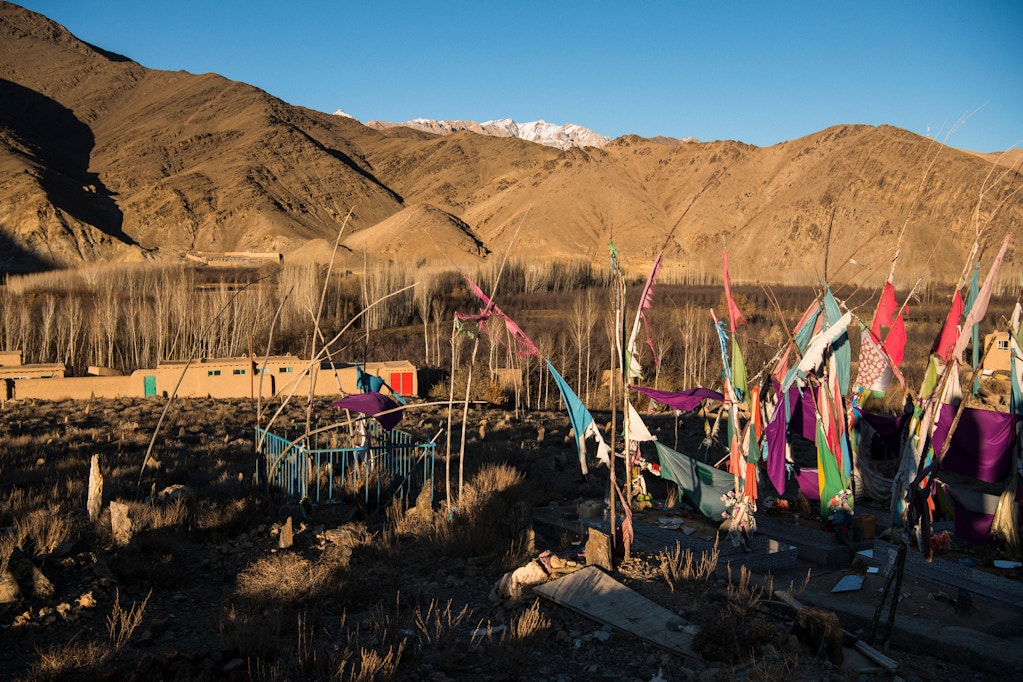
Flags mark the graves of a mother and three children, ages 6, 8, and 15, who were killed in a 01 night raid in the village of Sher Toghi, Daymirdad District, on the night of March 2 and the morning of March 3, 2019. The 15-year-old was shot when he ran outside to look for help after a bomb hit the family home. Relatives found the bodies of the mother and daughters beneath the ruins of their house the next morning.
Photo: Andrew Quilty/Agence Vu
THE UNCHECKED VIOLENCE of 01 was in line with U.S. President Donald Trump’s increasing normalization of war crimes. Since late 2019, Trump has overruled senior military commanders who sought to discipline a Navy SEAL for inappropriate and criminal actions, rolled back a ban on the U.S. military’s use of land mines, and pardoned soldiers convicted or accused of murdering Afghans. In September, the U.S. sanctioned senior officials from the International Criminal Court in response to its investigations into whether U.S. forces committed war crimes in Afghanistan. Secretary of State Mike Pompeo called the court’s efforts “illegitimate attempts to subject Americans to its jurisdiction.”
Comment: What can Americans expect but hatred when their ZIONIST leaders like Trump and Biden sanction the torture and murder of school children, their mothers, and teachers? How would we like it if they came here and bombed our churches during Sunday Service? This is what CIA/Special Ops DO!
Soon after his January 2017 inauguration, Trump ordered his national security advisers and then-Defense Secretary James Mattis to come up with a new strategy to fulfill an election promise: withdrawing from Afghanistan.
Trump’s plan for pulling out relied on a minimal number of elite troops using brute force tactics to coerce the Taliban into negotiating from a position of weakness. Tactical directives adopted in 2007 and strengthened by three successive Obama-era U.S. military commanders in Afghanistan — before being slightly loosened in 2010 under Gen. David Petraeus — had been designed to reduce civilian casualties, but the Trump administration further relaxed those directives, expanded the authority of battlefield commanders, and deployed 3,000 more American troops.
In an August 2017 speech unveiling his new Afghanistan and South Asia strategy, Trump defended his approach, pointing to the “dramatic results in the campaign to defeat ISIS” achieved under the same directives in Iraq, where the battle of Mosul was winding down, and where, according to Airwars, coalition air or artillery strikes led to a conservative minimum of 1,066 civilian deaths between October 2016 and July 2017.
In October 2017, Pompeo, then-director of the CIA, indicated that the agency, too, would pursue a more hawkish posture. The CIA, he said, “must be aggressive, vicious, unforgiving, relentless.” Pompeo did not specify where the new stance would take effect or with whom, instead referring generically to “partner services throughout the world.” Soon after, the CIA reportedly expanded its activities in Afghanistan, working closely with Afghanistan’s NDS and American special operation forces to hunt targets previously considered below their pay grade.
Comment: Pompous Pompeo hope you are abandoned in one of these madrassass as Americans bomb the shit out of you. Pompeo is a vicious evil man.
The diplomatic part of the strategy emerged a year into Trump’s presidency, when his administration sidelined the Afghan government and began negotiating directly with the Taliban in Doha, Qatar. In September 2019, Zalmay Khalilzad, an Afghan-born American diplomat serving as U.S. special representative for Afghanistan reconciliation, announced that the U.S. had reached a preliminary deal “in principle” with Taliban leadership. Experts expected the agreement to lay out a withdrawal timeline for international forces, lead to talks between insurgent leaders and the Afghan government and, hopefully, end the war. But Trump called off the talks abruptly after an American soldier was killed in a suicide bombing on September 8, 2019. That same day, Pompeo, who had since been elevated to secretary of state, said that more than 1,000 Taliban members had been killed in the past 10 days, vividly illustrating the contrast between the rhetoric of peace and the escalating battlefield violence.
By this time, the parameters that had limited the use of U.S. counterterrorism tactics to hunting Islamic State, Al Qaeda, and high-level Taliban targets had long-since been abandoned. “We are not nation-building again,” Trump had said in his 2017 speech. “We are killing terrorists.” Analysts reasoned that Trump’s escalation of force was aimed at diminishing the Taliban’s standing at the negotiating table. But American enemies weren’t the only ones paying a price in Afghanistan.
Comment: American/CIA foreign policy generally supports terrorists and mass kills innocent Children.
In the first half of 2019, for the first time since they began counting a decade ago, the United Nations Assistance Mission in Afghanistan said pro-government forces were responsible for more civilian deaths than the Taliban. The talks in Doha resumed in December 2019. On February 29, following the success of a weeklong ceasefire, the Taliban and the U.S. signed an agreement that all sides hoped would pave the way to ending the war.After the peace deal was inked, the strike force units appeared to vanish.
The period in which The Intercept documented the escalation of violence in Wardak falls neatly between the first round of formal U.S.-Taliban talks in late 2018 and the signing of the Doha agreement early this year. The rate of 01 night raids, and the number of civilians killed as a result, fell dramatically last winter and stopped almost entirely this spring. Spokespeople from both the CIA and NATO-led Resolute Support declined to say whether there was a correlation between the end of the raids and the signing of the Doha agreement, but the timing is hard to ignore. After the peace deal was inked, the strike force units themselves appeared to vanish. A security analyst told The Intercept that, apart from one operation in May, she’d have thought “the earth had swallowed them whole.”
That was a major shift from 2019, when targeted night raids and airstrikes were being used countrywide against low-level Taliban field commanders, rank-and-file fighters, heroin cooks — seemingly, anyone whose daily activities brought them into contact with the insurgents. In much of rural Afghanistan, that meant not only grown men, but boys as well.

A crescent moon lit by the rising sun above a mosque in the village of Araban in Wardak’s Chak District. Mosques and Islamic schools, known as madrassas, were regularly targeted by 01 throughout Wardak in late 2018 and 2019, killing 33 religious students, according to The Intercept’s investigation.
Photo: Andrew Quilty/Agence Vu
More than 6,000 madrassas are registered with the Afghan government, but many others operate in areas beyond their control. A journalist from Wardak, who asked not to be named because of the sensitivities of working in the province, estimates there are up to six madrassas in each of the four predominantly Taliban-controlled districts where The Intercept documented civilian deaths. Madrassas have long been ripe recruiting grounds for militants. Most students come from poor families, and although some madrassas incorporate nonreligious classes, few boys receive formal education outside the religious schools.
“Madrassas are mostly considered the epicenter of [the] Taliban,” said Fazal Muzhary of Afghanistan Analysts Network, an independent research organization based in Kabul. Taliban, after all, means “religious students,” and the group’s earliest recruits were drawn from madrassas in Afghanistan and Pakistan. But most madrassas in Afghanistan have rules banning weapons that are generally respected by local fighters. “Some [madrassa students] will join us but this is up to them,” Mullah Abdul Rahman, a Taliban commander in Daymirdad District, told The Intercept in November.
01 may target religious students because they know the Taliban recruit from madrassas and so assume guilt by association, said Gossman, of Human Rights Watch. As a result, beginning in 2019, some Wardak families forbade their boys from studying in madrassas, while others moved out of the province altogether. While security forces can search madrassas and arrest suspects under international law, Gossman said, the cases documented by The Intercept “appear to be summary executions.”
RelatedTaliban Peace Talks Must Not Ignore CIA-Funded Afghan Militias, Report Says
The future role of CIA operatives and the Afghan units they advise is a critical area of the peace deal with the Taliban, but no details about it have been made public. Taliban leaders have reportedly demanded reductions in the CIA presence in Afghanistan, but it’s unclear whether the issue was included in the agreement’s classified annexes, which have only been viewed by top Taliban and U.S. officials and a handful of members of Congress. Some Trump administration officials sought to increase the CIA’s footprint as the military withdrew, a move the Taliban and the Haqqani network, its powerful and violent affiliate in eastern Afghanistan, have long opposed.
The CIA is already allowing the strike force units to conduct operations on “a fairly loose leash,” says Erica Gaston, a nonresident fellow with the Global Public Policy Institute in Berlin. “I don’t think any Afghans have authority over them,” Gaston said.
Even if regular U.S. forces pull out, the CIA could maintain the operational capacity of some of its Afghan surrogate units. “The well-trained and well-equipped CIA militias would be particularly valuable” and “constitute a formidable set of actors in their own right,” a 2019 Watson Institute for International and Public Affairs report notes. “Given their highly paid and somewhat privileged status, they are unlikely to welcome a drastic reduction in pay that would accompany integration into the regular armed forces or demobilization. If cut loose by the CIA, they may be reborn as private armies … in the service of powerful individuals.”

Inside an Afghan National Police checkpoint on the outskirts of Maydan Shahr, the capital of Wardak Province, which has come under increased pressure from the Taliban since the insurgent group signed a peace deal with the U.S. government in February.
Photo: Andrew Quilty/Agence Vu
THE TALIBAN’S PRESENCE in Wardak is discreet but pervasive. The provincial capital, Maydan Shahr, lies about 30 miles southwest of Kabul. A wedge of shops and homes between two highways that meet at a roundabout, it is more thoroughfare than city. Maydan Shahr’s decrepit bazaar is a shamble of one and two-level clothing stores with gaudy girls’ dresses hanging in windows, fronds of rebar sprouting from roofs, and kebab restaurants spewing greasy blue smoke.
The larger of the two highways, nominally under government control, follows the wide Wardak valley south, leading eventually to Kandahar. Beyond Maydan Shahr, in Wardak’s rural districts, police occupy a dwindling number of checkpoints along the highway but are scarcely visible on the road nowadays, even during daylight hours. Surviving a trip outside their base after dark now is a virtual coin-toss, according to several members of the ANSF, or Afghan National Security Forces, in Wardak.
This year, since the U.S. agreed to curtail the use of air power, the Taliban regularly detonate roadside bombs, mount ambushes against government military convoys, and set up temporary checkpoints, searching cars for government workers before melting back into the landscape. In the mountains after dusk, dim lamps can be seen trickling down the valleys like leaves in a stream. Those lights are the Taliban, the commander of a police outpost near Maydan Shahr told The Intercept one night in August, “coming down from the mountains.”“The rest of [Wardak] is done. It is with the Taliban. Maydan Shahr is all that’s left.”
In Wardak’s southern districts, the government’s presence is limited to a handful of besieged buildings. The governors of three of those districts live in exile in Kabul, traveling to their constituencies once or twice a month in heavily armed convoys, or whenever a helicopter is available.
During last year’s presidential elections, a total of 73 votes were counted across all of Wardak’s Nerkh District, according to a senior government official from Nerkh. “All of those were ANSF,” said the official, who asked not to be named because he feared repercussions for speaking openly. Even the election staff had to be carried in and out by helicopter. The embarrassingly low turnout was due at least in part to explicit Taliban threats not only to election officials, but to voters as well. Days before to the vote, the insurgent group issued a statement dismissing it as a “fraudulent process … undertaken to mislead the people … and secure [the] interests of the invaders.”
“The rest of [Wardak] is done,” the veteran NDS officer from the province told The Intercept. “It is with the Taliban. Maydan Shahr is all that’s left.”
Raids by 01 were part of the problem, some residents say. “The more they terrorize, the more our numbers increase,” Taliban spokesperson Zabihullah Mujahid told The Intercept. “Such attacks will have no adverse effect on morale of our mujahideen. On the contrary, they have a positive effect.” The Taliban is known to exaggerate facts and figures for propaganda purposes, but the correlation between misconduct by foreign forces and Taliban recruitment is well documented.
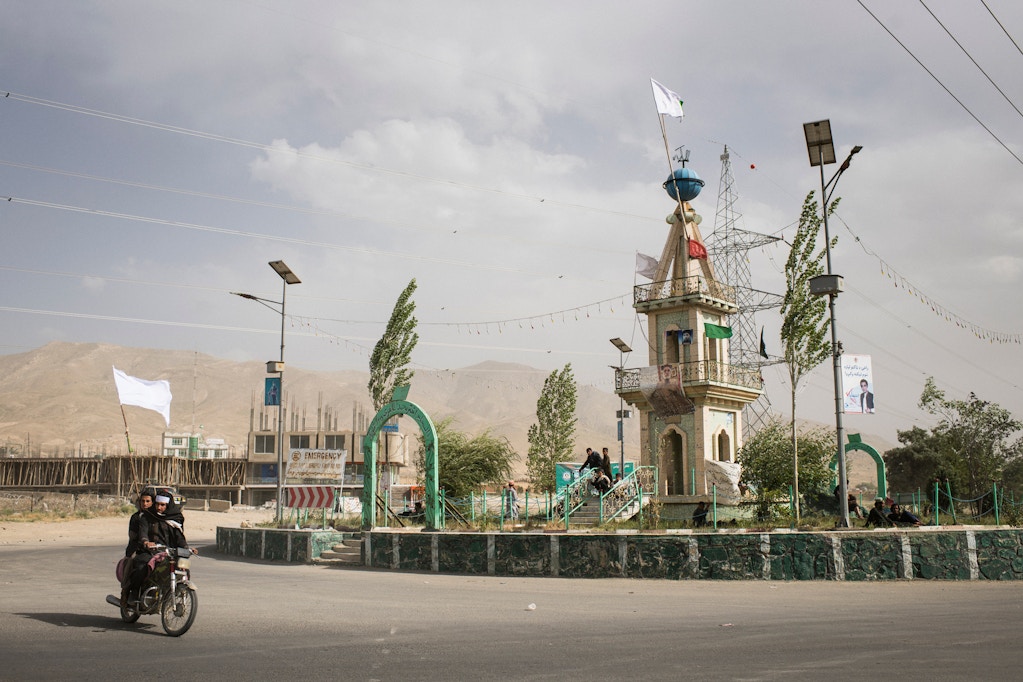
On the third and final day of the first-ever ceasefire between Afghan government and Taliban forces in June 2018, the main traffic roundabout in Wardak’s capital Maydan Shahr was topped with a white Taliban flag. The ceasefire saw Afghan security forces and Taliban insurgents crossing into territory under the other group’s control and embracing in the streets. Afterward, the war resumed as if it had never stopped.
Photo: Andrew Quilty/Agence Vu
In a rare alignment of views, Mohib, the Afghan national security adviser, concurred that the strike force units were undermining government efforts to defeat the Taliban. “I personally disagree with how we conduct counterterrorism,” Mohib said in an interview last year. “I think the way we address grievances needs to change and we need to look into why people are fighting and what can be done to encourage them otherwise.”Only the U.S. president has authority over American covert actions.
Comment: CIA Answers directly to the United States President.
The units occupy a shadowy area outside of official Afghan government control. The bilateral security agreement signed by the U.S. and Afghan governments in 2014 when the U.S. military ceased combat operations there states “there is no mechanism for any independent [U.S.] operation” without the approval of the Afghan government. But Title 50 of the U.S. Code allows covert actions “to influence political, economic, or military conditions abroad, where it is intended that the role of the United States Government will not be apparent or acknowledged publicly.” Only the U.S. president has authority over American covert actions.
“Any Americans in command of or accompanying these units would fall under Title 50,” Gossman told The Intercept, including their CIA trainers.
Although the formation of the units was never publicly announced, 01 and 02 are likely among those Pompeo was referring to when he spoke of “a network of partner services throughout the world who are willing to share information, run operations with us, and help us achieve our priorities.”
In response to a Human Rights Watch report last year documenting abuses by the strike force units, the CIA said that “many, if not all, of the claims leveled against Afghan forces are likely false or exaggerated.”
Comment: CIA are liars. They LIE LIE LIE LIE LIE. They even screw their own officers allowing their id’s to be know so they will be murdered. Saves pension money I guess.
“[T]he United States is committed to the rule of law,” the CIA said at the time. “We neither condone nor would knowingly participate in illegal activities, and we continually work with our foreign partners to promote adherence to the law. We also take extraordinary measures … to reduce civilian casualties … and to strengthen accountability for our actions and those of our partners.”
Comment: CIA believes in MOB rule and is In Charge of the Italian Mafia. Under the CIA the Mafia now drug deals and CIA is heavily involved in Child rape rings, snuff films and child prostitution even kidnapping children for their evil, satanic Mind Control Satanic Slavery.
Afghan President Ashraf Ghani faced extraordinary public pressure last fall, after 14 civilians were killed in several strike force raids in eastern Afghanistan. Then-NDS Chief Masoom Stanekzai resigned, and Ghani tweeted that the last of the deadly raids occurred “despite previous assurances and changes in guidelines” and that he had “ordered the attorney general to investigate this incident immediately, and to bring the perpetrators to justice.” A spokesperson for the attorney general’s office said this summer that “our report is complete and has been sent to the Presidential Palace.” Without elaborating, he said the report “requires further investigation from NDS.” The report has not been made public, and a palace spokesperson did not respond to The Intercept’s inquiries about it.
“In Nangarhar, [02] has been stopped — prevented from making any further operations” until the government can get to the bottom of it, Mohib told The Intercept in September 2019. But members of 02 painted a different picture. A current 02 member told The Intercept in late 2019 that he understood the unit would be “regulated,” but another said the unit’s operational tempo had neither stopped nor slowed.
Stanekzai didn’t fall far. After leaving his NDS post, he was named leader of the Afghan government’s negotiating team in talks between the government and the Taliban. He initially agreed to an interview, but his spokesperson stopped answering The Intercept’s calls after 01 was mentioned. The same happened with other NDS spokespeople. The Afghan ministers and deputy ministers of defense and interior either declined or ignored several interview requests.
Last September, according to the Afghanistan Times, an English-language newspaper published in Kabul, tribal elders from Wardak met with Ghani to demand an end to night raids, plus new measures to prevent civilian deaths in the province. According to the article, the Afghan president nodded.
“Wardak [and] these places around Kabul are infested with terrorists and insurgents, so [01] couldn’t be fully stopped, but they’ve been issued with cautions that full procedures … and the rules of engagement need to be followed,” Mohib told The Intercept.
If the 02 unit — based in Nangarhar province — were stood down for even one night, a former member told The Intercept last October, “the entire eastern zone would collapse.”

Ahmad Jamal, 56, shows scars from shrapnel wounds and subsequent surgeries from American airstrikes on his family home in Sher Toghi on the night of March 2 and the morning of March 3, 2019. He lost his wife and three of his seven children in the attack. Ahmad Jamal and several surviving children were flown to an NDS hospital in Kabul, where he says they were given rudimentary medical care, refused pain medication, and chained to beds. Three days later, they were dumped by the side of the road near the Intercontinental Hotel in Kabul.
Photo: Andrew Quilty/Agence Vu
STRIKE FORCE UNITS like 01 and 02 are distinct from Afghan special forces units under the command of the Afghan National Army, Afghan National Police, or the NDS. From the moment their members are approached for recruitment, procedures and practices veer away from those they’d experienced in their previous ANSF roles. From vetting through training, intelligence gathering, mission planning, operations, and the consequences should something go wrong, the experiences of the two tiers of fighters rarely converge.
Background checks for those earmarked by recruiters take at least six months. The lure of salaries several times higher than those offered to regular special forces is worth the wait. Strike force members are said to be paid $600 to $1,800 per month in U.S. dollars. The payments are made in cash, allowing soldiers’ identities to remain unknown even to the Afghan government. (Low-ranking Afghan National Army soldiers, by contrast, are paid between $210 and $235 per month, according to several soldiers who spoke with The Intercept, and their salaries are directly deposited into bank accounts.)
Comment: CIA’s Psychopath Factory above.
Training for the strike force units is provided primarily by American advisers and far more rigorous than what other Afghan special units, who also receive instruction from American military personnel and contractors through the Resolute Support mission, undergo. While members assigned to intelligence gathering roles contribute to target selection, all targets are ultimately chosen by the CIA, unit members say.All targets are ultimately chosen by the CIA, unit members say.
The American advisers are in charge of mission planning for the strike force units. They “have complete information on [the] targets,” which are referred to as “jackpots,” said the former 02 member, borrowing a term commonly used by U.S. special forces. During pre-mission briefings, the former 02 member said, advisers paint vivid portraits of their targets, describing their alleged crimes, in an effort to rouse the wrath of the fighters. (Comment: CIA KNOWN TO TELL HUGE LIES to get desired results.) Neither provincial government officials nor local security forces are warned of the missions in advance. “People in government are connected,” said the current 02 member. “The information could leak.”
Since the end of 2018, almost all of 01 missions’ ground forces were transported to and from their target locations in American CH-47 Chinook helicopters. They were accompanied by a variety of weaponized American support aircraft, including drones, jets, attack helicopters, and heavily armed “close air support” aircraft designed specifically to support ground forces facing enemy fighters. Few strike force missions appear to be conducted without U.S. personnel on the ground, according to government and security officials from Wardak, strike force unit members, and the NDS counterterrorism official who used to accompany 01 on some raids. The raids in Wardak were constant, yet it was almost impossible for Taliban fighters to predict their exact locations. The overwhelming force applied by 01 and the fearsome reputation they built meant they were rarely challenged on missions.
The accounts of those who survived raids on their homes or villages hewed to a familiar pattern: Helicopters would drop the ground forces near their target location around 10 p.m. The sounds of gunfire and explosions would come and go for several hours. Sometimes the voices of the paramilitaries could be heard, and sometimes it was those of their victims. The helicopters would return and depart with the ground force around 4 a.m. Villagers would warily come out from their homes before sunrise to find who 01 had chosen as their latest victims.
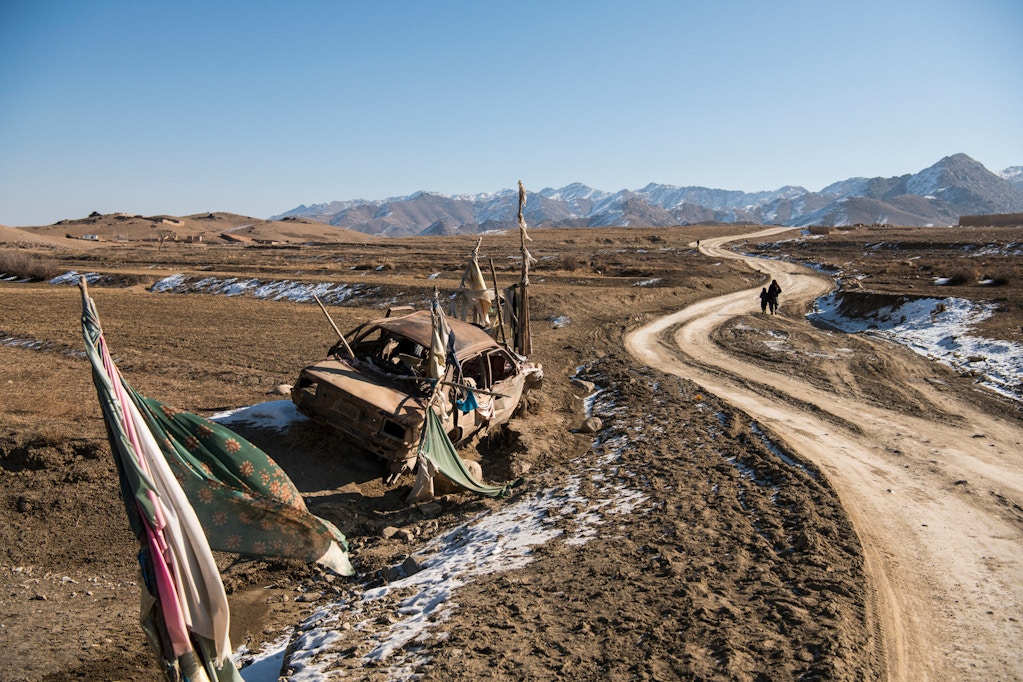
The remains of a car struck by a missile fired from what witnesses said was an American attack helicopter one night in October 2018 near a road in Sebak in Wardak’s Chak District.
Photo: Andrew Quilty/Agence Vu
“We live in the battlefield. We know the difference between the 01, the [Afghan National Army], the police, and the foreigners,” said Abdullah, an elderly Nerkh resident who has witnessed night raids and been detained by a unit he believes was 01. “With the [Afghan] national army, these planes — the fighter planes and the helicopters — do not really come. But with 01, we know [it is] them because planes are always with them: drones, helicopters, fighter jets. [And] Americans come with them.” (The Afghan Air Force does not possess or operate fighter jets, weaponized drones, Chinook helicopters, or AC-130 gunships.)
After years of hearing the sound of warplanes, residents like Abdullah can also distinguish between the sounds of attack helicopters and Chinooks (which are used for transport), jets, drones (known as “bangana,” or mosquito), and the much-feared AC-130, which locals call “jaaz.” The AC-130 is the same bulky passenger plane — typically retrofitted with a rapid-fire Gatling gun, a 40 mm Bofors anti-aircraft cannon, and a 105 mm howitzer — that destroyed a functioning hospital run by Médecins Sans Frontières, killing 42 in Kunduz in 2015.
“Every night, the AC-130J is flying,” Col. Terence Taylor, commander of Combined Joint Special Operations Air Component–Afghanistan, told Stars and Stripes last year. “The people they are supporting are requesting them every single night.” While supporting 01 missions, aircraft crews often fire randomly into surrounding hills in so-called shows of force, aimed at intimidating supposed enemies on the ground.
The American advisers are aloof, according to the current and former strike force members, only interacting with their Afghan counterparts on operational matters. Advisers to 02 dress in civilian clothes and operate from a building behind the Afghan unit’s barracks in Camp Dyer, the U.S. Special Forces base inside Jalalabad Airfield. On missions, the Americans generally wear green camouflage in the style of U.S. Army Special Forces, but some wear Afghan-issued uniforms.“Whatever the foreigners say, we do. … [We] are not decision-makers; we are implementers.”
While CIA officers run the operations, most of the ground support during strike force unit missions, including the control of air power, is provided by fighters loaned out by Joint Special Operations Command. Variations on this arrangement have been used by the CIA since the Church Committee clamped down on agency excesses at home and abroad in 1975. Originally dubbed “Omega” in Afghanistan, the program temporarily strips special forces of their regular military designation — a process known as “sheep-dipping”— and places them under CIA command. This enables the CIA to circumvent the restrictions placed on fighters who ordinarily operate under regular wartime Title 10 authority, placing them instead under the agency’s Title 50 authority for covert actions.
None of this is shared with strike force members, however. When a 02 member asked what branch of the U.S. government or military their advisers worked for, the American response was curt: “We work for the Afghan government.”
Strike force intelligence officers are given sophisticated satellite mapping smartphone applications and others that conceal surveillance photographs and intelligence information behind innocuous-looking facade apps, the current 02 member told The Intercept, noting that some of 02’s best sources are Taliban commanders who think the government will spare them if they help.
On missions, one American adviser accompanies each of several squads of between seven and 10 fighters; every adviser is assigned an Afghan interpreter, the former 02 member said. Once on the ground, “whatever the foreigners say, we do,” the current 02 member said. “02 forces don’t have permission or authority to object,” they added. “[We] are not decision-makers; we are implementers.”

On either side of the hill are two entrances to the main valley of Wardak’s Nerkh District, as viewed from a hilltop police checkpoint on the southern edge of Maydan Shahr, the capital of Wardak.
Photo: Andrew Quilty/Agence Vu
IN THE YEARS after the 2001 U.S. invasion, people in Wardak, as in much of the country, laid down their weapons. But in Wardak, the detente wasn’t followed by the development dollars that began pouring into other parts of Afghanistan. Despite its proximity to Kabul, it was a third-tier province of little strategic importance. The spectacle of the nearby capital — where foreign money created jobs, paved roads, and built flashy apartment buildings, shopping centers, and schools — fueled resentment in Wardak, which remained poor and undeveloped.
By 2006, Shuhrat Nangyal, an author from Wardak who has written more than 50 books on Afghanistan, says that resentment turned to anger. Wardak was fertile for revolt. Village clearance operations conducted by international troops further roiled the population. The Taliban mobilized and, like elsewhere in the country, moved toward all-out insurgency.
For a few years after American troops arrived in Wardak, there was little fighting, Mullah Abdul Rahman, a Taliban commander in Daymirdad District, told The Intercept. “They were just taking people’s guns. It was peaceful, everything was relaxed.” But when U.S. activities there turned more belligerent — “destroying things and killing people” — the Taliban in Wardak began to reorganize. “We started fighting against them and tried to force them out.”“All our dreams went upside down,” said Gul Rahman, whose 13-year-old brother was killed last year.
“All our dreams went upside down,” said Gul Rahman, a 37-year-old Daymirdad resident whose 13-year-old brother was killed in what he believes was a 01 night raid in May last year. The Americans promised prosperity, he said, but instead brought “insecurity and instability.”
Wardak was the site of several major incidents that turned local populations against the Americans and spurred a wider sense of grievance. In 2009, American soldiers were accused of burning Qurans during a patrol there, leading to countrywide protests. In 2012, then-Afghan President Hamid Karzai forced American special forces out of Wardak after a team of Green Berets was accused of torturing and murdering local civilians.
The province also has a deeply rooted antipathy toward militias. Horrific abuses were meted out by militia units against Wardakis in the final years of the communist regime in the mid-1990s. According to a 2011 HRW report, those memories contributed to Wardak elders pushing back against the creation of a new local force in 2009. Their efforts failed, and the force was set up anyway; complaints about abuse and corruption soon followed.
In 2019, according to the World Bank, 60 percent of Wardakis lived below the poverty line. “People who can afford to, [they] move to Kabul,” said Gul Rahman, but the “poor and helpless people remain in their village.” Many Wardak residents aspire to send their children to school and university in Kabul, but few can afford that luxury. Most boys complete a few years of school, then work on a farm to support their families. More than 70 percent of Wardak’s labor force works in agriculture, and only a quarter of girls and women over the age of 14 can read and write. For many parents, sending their sons to a madrassa, where boarding and tuition are free, is more pragmatic than ideological. A son who becomes an Islamic teacher or preacher also ensures a degree of long-term financial stability.
In Wardak’s Taliban-controlled areas, residents say, life is simple and austere. Time is dictated by the rise and fall of the sun and the five-times-a-day call to prayer. Months and years are measured by the changing seasons. Away from the front lines, aside from periods when night raids are common, it is also largely peaceful. “The one bad thing,” says Rahman, who was forced to leave school in the 9th grade to support his family, “is the poverty. But at least my family and the women are safe.”
“There’s no fighting,” he added. “Just night raids.”
Since the Doha agreement mandating the end of offensive operations against the Taliban by U.S. forces and vice versa was signed in February, Wardak residents deep in Taliban-controlled areas have enjoyed a marked decrease in violence. “There’s no bombardments or night raids,” said Fahim, a 23-year-old resident of Daymirdad District who lost several family members in a raid in March 2019. “The people are very happy — it’s like the time of Eid.”

Fahim, 23, suffered shrapnel wounds and was shot in the leg during a night raid on March 2 and 3, 2019, in the village of Sher Toghi, that killed his mother, a brother, and two young sisters, and seriously injured his father and another sister. Here, Fahim holds a fragment from one of at least two bombs that struck the house. Brian Caster, a weapons investigator with Amnesty International and former U.S. Air Force Explosive Ordnance Disposal officer, told The Intercept “the weapon used in this case was almost certainly a GPS-guided JDAM, an aircraft bomb dropped by American aircraft in Afghanistan.”
Photo: Andrew Quilty/Agence Vu
Aside from the general lack of governance and restrictions on women’s freedoms and nonreligious education, especially for girls, the Taliban controls that perhaps most affect daily life are those on communication. The Taliban is deeply suspicious of spies giving information to government security forces. Before the Doha agreement, that distrust was so great that cellphone service providers in Wardak were forced to switch off their towers for all but a few hours each morning or risk having them destroyed. Residents say the Taliban ban on television had also been reinstated in parts of rural Wardak. Some residents fear keeping photos on smartphones, or even the memory cards that hold them, which the Taliban have banned, lest they be accused of spying. Wardak’s districts are information black holes, which may be one reason so many atrocities there go unreported. Another, according to a Kabul media executive, is the pressure on Afghan news outlets not to report critically on the Afghan security forces.
Many Wardak residents told The Intercept that 01 is deliberately hunting civilians. “In Nerkh, it doesn’t matter if you belong to the Taliban or the government — you will be targeted,” said a former Omar Khail resident named Shaheen, whose house was destroyed by an airstrike the same night in December 2018 that the madrassa was raided. Shaheen moved to Kandahar’s notoriously violent Arghandab District, where, he told The Intercept last year, “security is much better.” (Arghandab was almost entirely overrun in a massive Taliban offensive this October and November.)Many Wardak residents told The Intercept that 01 is deliberately hunting civilians.
Years ago, when U.S. forces were based in Wardak, “they would only target the Taliban,” said Mawlawi Sadiq, a teacher at the Omar Khail madrassa. “Now, even the common people are being targeted.” After the madrassa massacre, and with word of other 01 raids spreading through the district, Sadiq estimates that about 20 percent of Omar Khail’s residents left.
Almost all Wardak residents interviewed by The Intercept said the Taliban, for the most part, stay out of residents’ day-to-day lives. In fact, their presence in general is inconspicuous. Small groups of fighters patrol villages at night and establish temporary checkpoints on the road to search for government workers or Afghan security forces. Fighters are less concerned about keeping out of sight since the virtual U.S.-Taliban ceasefire began with the signing of the Doha agreement in February, half a dozen Taliban commanders in Wardak told The Intercept in recent months. Generally, residents’ only interactions with Taliban fighters occur when the insurgents come looking for temporary accommodation or food.
In those cases, the people “don’t have any option,” said Amir Mohammad Malikzai, the governor of Wardak’s Sayedabad District.
But U.S. and Afghan government and security officials often view acquiescence to the Taliban’s presence in villages as tacit support and treat those who comply with the fighters’ demands as legitimate targets. Shuhurat Nangyal, the author from Wardak, puts it more bluntly: “01 have a mentality that these people [living in Taliban-controlled areas] are the enemy — ‘kill them.’”
In reality, sympathy for the Taliban in Wardak derives mainly from the group’s religiosity, which comports with local traditions. Just as important, however, is residents’ loathing for a central government they see as corrupt and having failed to serve their needs, and from animosity toward its security forces. “No one wants a Taliban government there; they’re against it,” Nangyal said. At the same time, “no one wants the Taliban to be disrespected. If you kill a Talib [in Wardak], you kill a Wardaki.”
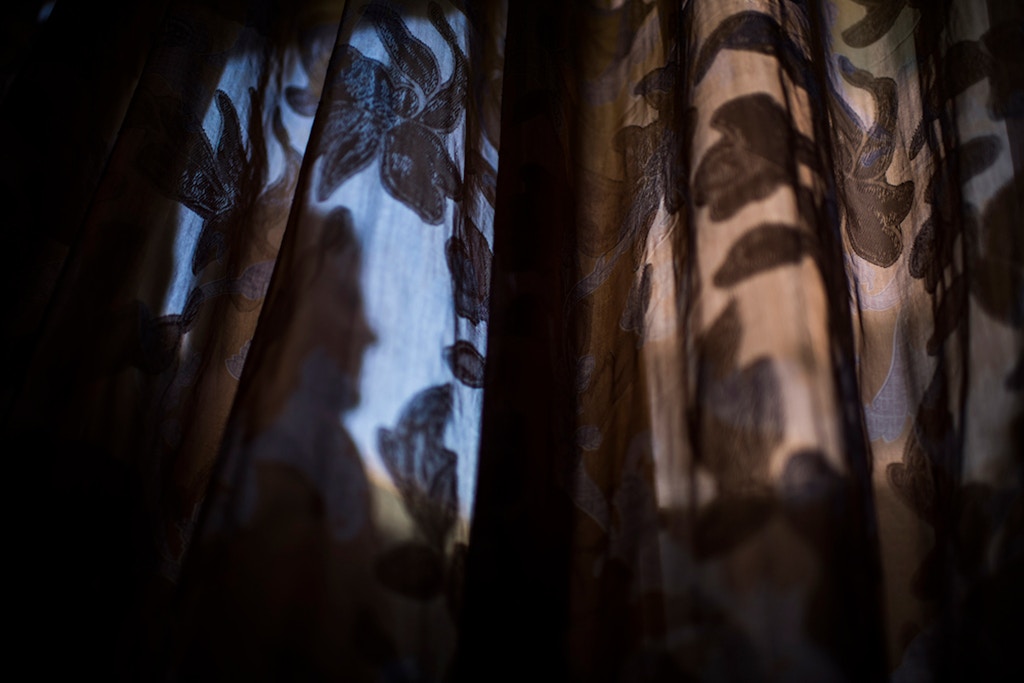
Mortazawa, 23, was home in Omar Khail in late 2018 when a night raid targeted students in the nearby madrassa. He didn’t know Mawlawi Sadiq, one of the teachers at the madrassa, well but described him as an innocent-looking man. “He didn’t declare any sympathy for either the Taliban or the government,” Mortazawa said. “He just taught his students.”
Photo: Andrew Quilty/Agence Vu
HOURS BEFORE SUNRISE on Saturday, December 15, 2018, a few dozen boys from Wardak left their villages in ones and twos to make the weekly voyage to the madrassa in Omar Khail, where they would live and study for five days before returning home to spend the weekend with their families.
Jamshid and Assad Khan had about two miles to walk, a trip that usually took an hour. The brothers had studied together in the Omar Khail madrassa for four years and knew the route well. Jamshid, 13, was already a Qari, someone who recites the Quran. Some evenings after classes at the madrassa, he and 10-year-old Assad Khan would play cricket with the other students until dark.
The boys’ shoes were old and barely held together with glue. Before Jamshid and Assad Khan set off that morning, they’d asked their father to bring them new shoes from Kabul, where he worked during the week importing goods from Pakistan and reselling them to local merchants. He promised them he would.
Boys came from across Nerkh that morning. 12-year-old Malik Urfan came from Tokarak on his bicycle; 12-year-old Safi, carrying his bedding for the week, traveled in a shared taxi with his cousin Jalal from Pirdad — as madrassa students, they didn’t have to pay; Kamran, also 12, cut across fields on foot for an hour from Suliman Khwar; and brothers Arman and Rafi, 12 and 9, walked together from nearby Kosai. The sky was still dark by the time several dozen boys, including those from Omar Khail, had joined their teacher, Mawlawi Sadiq, and the other faculty for the start of the week.
Three days later, on the evening of Tuesday, December 18, after the boys and teachers living nearby had gone home for the night, the remaining 25-30 students sat down to a dinner of potatoes, red beans, and bread. By 10 p.m., they were asleep in rooms that ran along a corridor at the front of the building or in the basement, which was warmer in winter.


Left/Top: A view of the Omar Khail madrassa courtyard, which was raided by 01 forces and their American advisers in December 2018. Right/Bottom: The exterior of the Omar Khail madrassa.Photos: Obtained by The Intercept
Around 6 p.m., Mortazawa, a 23-year-old shopkeeper, was at home with his family in Omar Khail when he heard the faint, mosquito-like buzz of a drone high above. He knew there would be a raid that night.
It was 10:30 p.m. when, inside his family home directly across the road from the madrassa, Mohammad Ghafar heard several aircraft roaring overhead. By now, he said later, he knew them all by ear. One he heard — an AC-130 gunship — signaled the presence of soldiers on the ground. Another resident said the planes were flying so low that the windows of his house shook.
Ghafar moved upstairs and peered out a small window facing across the road toward the madrassa. Minutes later, a column of hulking, armored vehicles lumbered into the village. Soldiers walked beside the vehicles, passing beneath his window. “There were mixed Afghan soldiers and Americans,” Ghafar recalled.
The convoy moved on, checking the area, then returned to the front of the madrassa. Dozens of soldiers moved up the driveway on foot. Ghafar heard a loud explosion and saw a flash of light. They had blown the madrassa’s front gate in. Ghafar shrank away from the window and hurried back to his family downstairs.
By this point, though the houses in the village remained dark, nearly everyone in Omar Khail was awake. A fruit seller said his two younger sisters were terrified. “Everyone was trying to keep them quiet. Sometimes my father would hold them, sometimes my mother and sometimes me.”
The men in the village were worried too. They had heard stories of 01 targeting civilian houses in Wardak. It was the consistency of tactics, as well as their resources and capabilities, that defined 01 throughout the province. That, and the blank stares victims’ families and local elders were met with when they confronted government authorities later about the damage and deaths.
Inside one of the madrassa’s dormitory rooms, 12-year-old Bilal was cowering with seven other boys after the two Afghan soldiers who had burst in left with the two oldest-looking students. “There were Americans in the corridor,” he told The Intercept. “We could hear them speaking.”
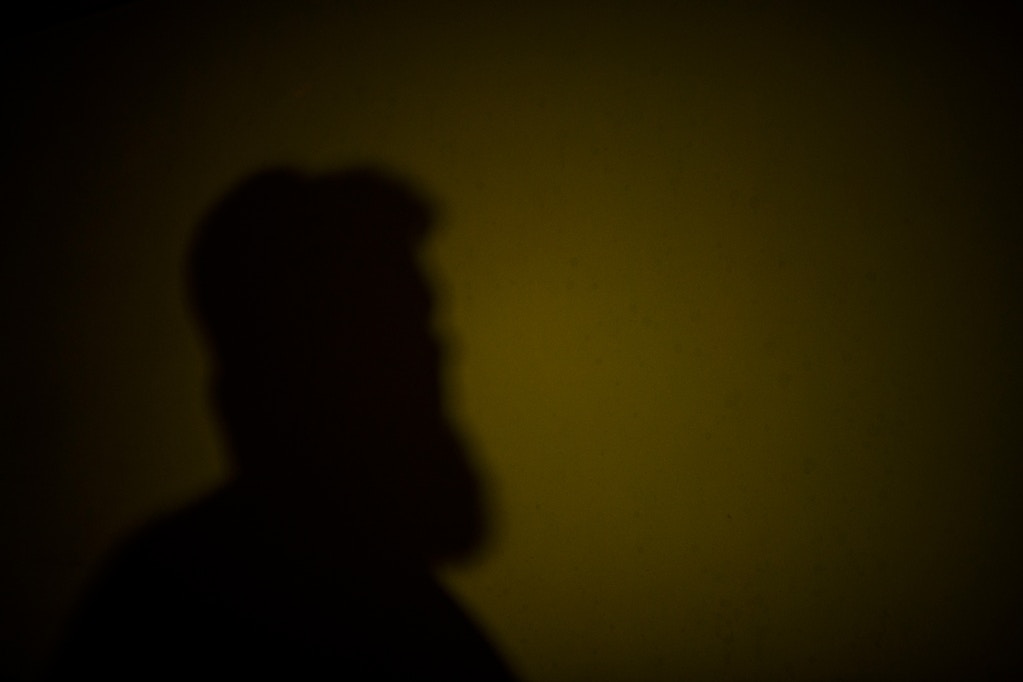
The shadow of Mawlawi Sadiq, one of four teachers at the Omar Khail madrassa. Asked whether there was any chance the boys killed that night in December 2018 were members of the Taliban, Sadiq was adamant: “No, there’s no chance,” he said. “I knew those boys’ activities. They were children.”
Photo: Andrew Quilty/Agence Vu
MAWLAWI SADIQ, one of four teachers at the madrassa, began his first job teaching young religious students seven years ago in Omar Khail. The Taliban only had a minor presence in the village then; within two years, however, it was firmly under their control. But Sadiq maintained a careful neutrality, several residents said. He “didn’t declare sympathy for either the government or the Taliban,” one man recalled. “He just taught his students.”
Sadiq and his family were also awakened by the clamor that night. Their house was at least half a mile from where the convoy had stopped near the madrassa, but his father called from another room: “Don’t go out! You’ll get shot!”
“All the sound stopped before the sun was up,” said Sadiq. After the dawn prayer, as the first wash of color filled the eastern sky, he left home with his brother. They walked quickly. Others came too; word had spread that the madrassa had been raided, and villagers converged from all directions.
“When I saw this horrible situation, I fainted,” said Sadiq, burying his face in his hands and weeping quietly as he recalled the scene. “When I imagine it,” he said, “it tortures me.”
Abdullah, a 50-year-old neighbor, was also there. “First, when we opened the doors, the boys couldn’t even walk or talk,” he said, referring to those who were still alive. “Their hands were trembling [and] their eyes were wild.”
The men walked the boys out, trying to shield them from the sight of the massacre. One of the survivors, an 8-year-old boy, saw inside a room where the twisted bodies of five fellow students lay strewn across the floor. “They’ll be back,” he told Abdullah, “and they’ll kill us.”
Cars were arranged to take the dozen or so surviving boys home.
When a pair of brothers, 7 and 8 years old, arrived home, their older brother Zainullah saw the looks of terror on their faces. “They couldn’t speak for three days,” he said. “When they did speak, they told us [the soldiers] took the elder students, stood them against the wall, and opened fire in front of our eyes.” The brothers said they were spared because of their youth.
One of the madrassa’s junior teachers — “he might have been 16” — was the oldest boy Abdullah saw among the dead. Men who recognized dead boys contacted their families; when phones didn’t work, they sent word by car. Before the fathers and brothers arrived, “we arranged the bodies and cleaned some of the faces,” said Abdullah. “We didn’t want the families to see where and how they’d been killed.”
Before long, a crowd had gathered, and one by one, the bodies were moved outside and driven away. Assad Khan and Jamshid, the brothers whose father had promised to bring them new shoes, were among the dead.
Their father, Mahmoud, was still in Kabul when his wife called in a panic. She didn’t say what was wrong but told him to come home straight away. On his way out of Kabul, he stopped at a bazaar and bought two pairs of children’s shoes. He arrived home mid-morning, not long after the bodies of his sons.“I knew those boys’ activities. They were children.”
“May Allah destroy them all,” he said, recalling the moment he saw his sons dead. There were many bullet wounds. In accordance with Islamic custom for martyrs killed in war, they were buried unwashed, wearing the clothes in which they had been executed.
The brother of two other boys killed in the madrassa vowed to retaliate against the Americans. “We are not in their country,” he told The Intercept. “They are in our country and attacking us. … I will take revenge for my brothers and all the other innocents killed.”
When Mawlawi Sadiq, the boys’ teacher, regained consciousness after fainting in the madrassa, he was at home. He was in such a poor mental state his father wouldn’t let him leave the house to attend any funeral prayers or burials.
The next day, he went to the madrassa. “There were shoes and books all over the place,” he said. “There were bullet holes inside the madrassa and also in the basement on the floors and walls. … There was blood everywhere.”
Asked whether there is any chance the boys were fighters, Sadiq was adamant: “No, there’s no chance,” he said. “I knew those boys’ activities. They were children.”
He hasn’t taught since the raid.
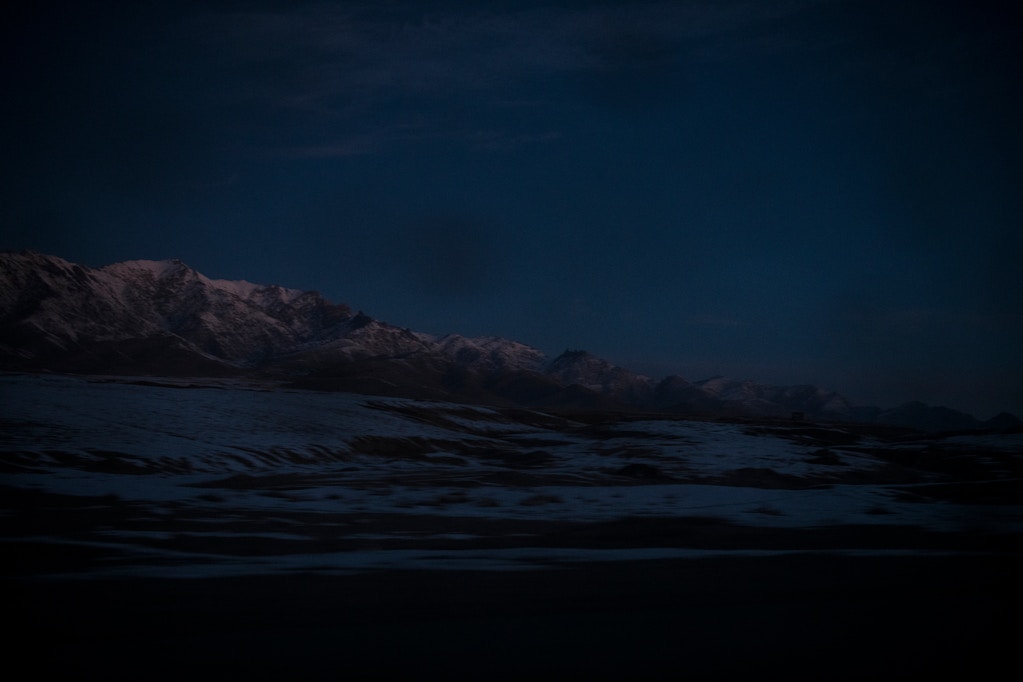
Mountains covered in this winter’s first snow in Wardak province, as seen from the Kabul-Kandahar Highway where it passes through Sayedabad District, at dawn.
Photo: Andrew Quilty/Agence Vu
TODAY, ASSAD KHAN and Jamshid’s father Mahmoud meanders listlessly between guilt, despair, and thoughts of revenge. Throughout the snowy winter after his sons’ death, he refused to wear shoes because he’d failed to provide them for his boys. When an irrigation canal that runs by his house flooded, he couldn’t bring himself to clear it. Eventually, water leached under the wall until it collapsed. Since Mahmoud had stopped working and had no money, his neighbors paid for the repairs.
Whenever he sees police or Afghan soldiers, he attacks them with whatever weapon is within reach. He has been beaten several times for his trouble. But his greatest fury is reserved for Americans. “If I take revenge,” he says, “if I kill at least two or three of them, the fire in my heart will end.”
His wife, Malika, has taken to rituals. On Thursday evenings, Mahmoud says, she lays the two silk turbans her sons wore at the madrassa on pillows and tells the room, “Today, my sons are coming home.” And, every morning and every night, she cleans the shoes Mahmoud brought home from Kabul and lays them out for her boys.












